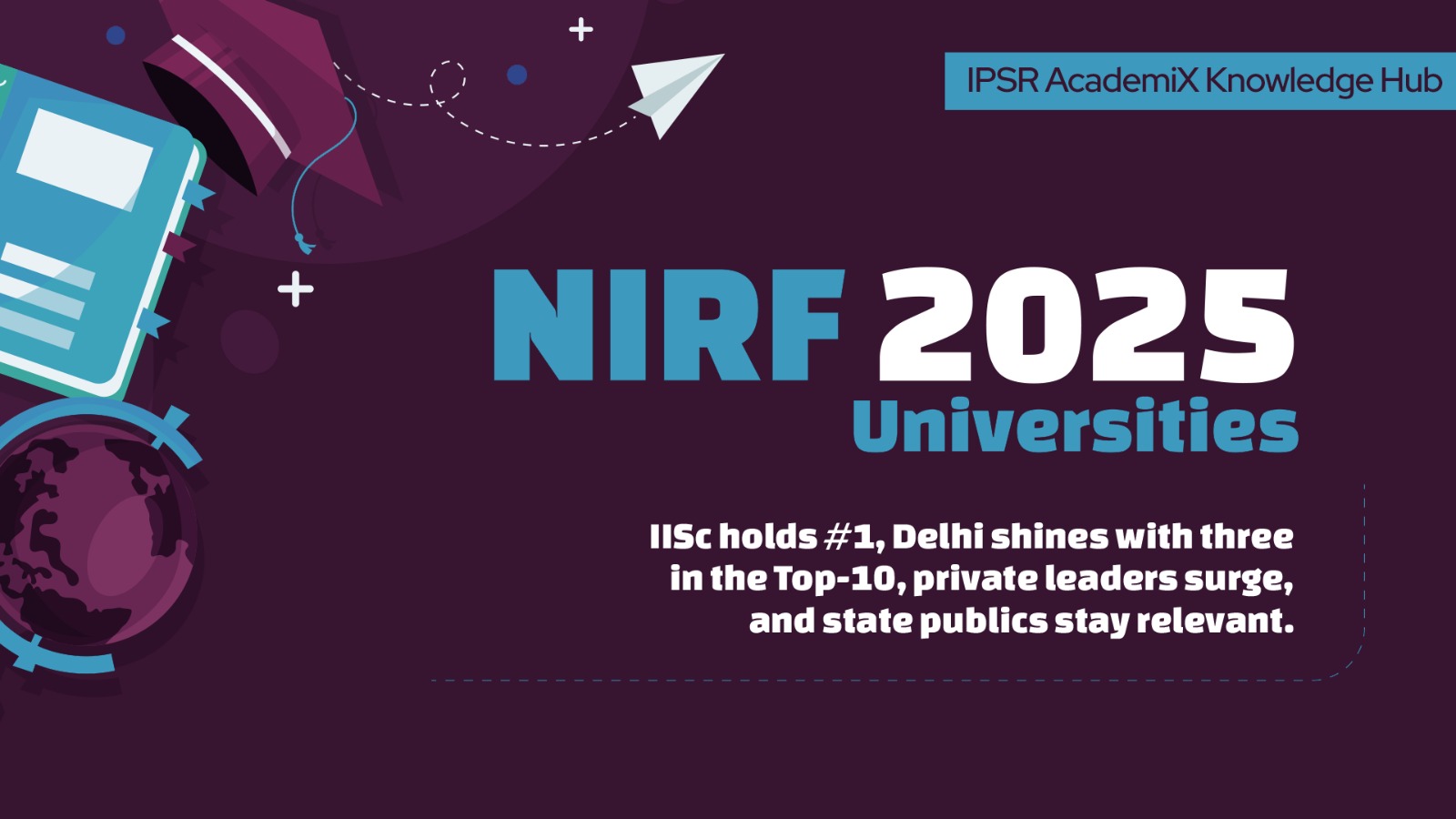
NIRF 2025 Rankings (Universities)
Insights and Analysis of India’s Academic Core
Sep-12-2025,
Articles
What the Top 100 Rankings Reveal About India’s Universities
The National Institutional Ranking Framework (NIRF) 2025, released on September 4, 2025, provides an in-depth snapshot of India’s higher education ecosystem. It evaluates universities based on five pillars of performance — teaching quality, research, graduate outcomes, inclusivity, and perception — offering stakeholders a comprehensive benchmark of academic excellence.
This year saw record participation:
- 7,692 unique institutions competing across categories.
- 14,163 applications, reflecting multiple-category entries.
This surge has intensified competition, making it significantly harder for universities to secure or maintain a place in the coveted Top 100. Even small gains or drops in performance now lead to substantial ranking shifts.
The Podium at a Glance: Top 10 Universities

Highlights
- IISc Bengaluru continues its dominance, holding #1 for the 10th consecutive year, powered by a strong research ecosystem and global reputation.pa
- Delhi shines, with three universities (JNU, JMI, DU) in the Top 5, reinforcing its position as India’s academic hub.
- Private sector gains traction: MAHE (#3), BITS (#7), and Amrita (#8) are now firmly among India’s elite institutions.
- Legacy public universities endure, with Jadavpur (#9) and AMU (#10) highlighting the relevance of state and central universities.
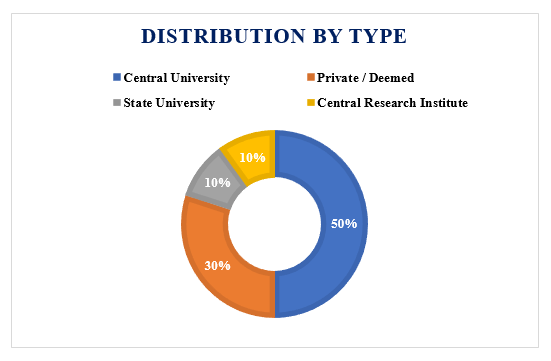
Participation Trends: More Institutions, Tougher Competition
The growing participation in NIRF reflects the expansion of India’s higher education sector, but also means:
- Greater volatility in rankings, especially for mid-ranked institutions.
- Small improvements in research or placements can push a university upward significantly, while minor declines can result in steep falls.
Understanding the NIRF Framework
NIRF’s stable scoring methodology allows universities to plan strategically.

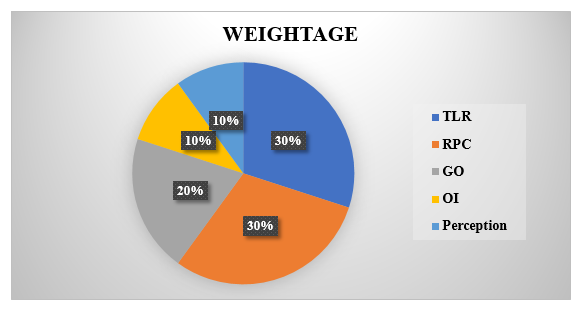
Key Insight:
With 60% of the weightage focused on research and teaching quality (RPC + TLR), universities seeking sustainable growth must prioritize faculty excellence, research funding, and infrastructure.
State-Wise Leadership: Who Dominates the Top-100
India’s top universities are concentrated in certain educational powerhouses. State-wise counts reveal where higher education is most competitive and where new growth is emerging.

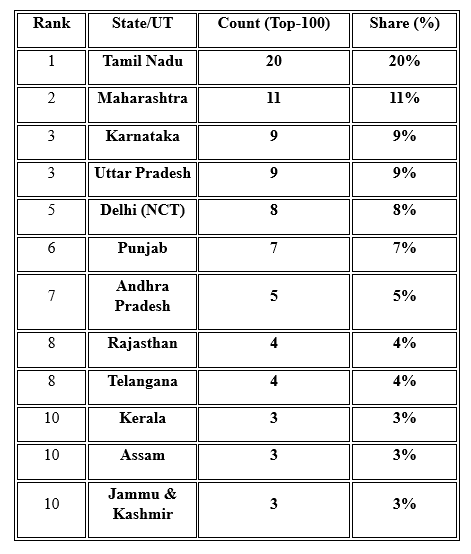
Together, these 11 states/UTs account for 86% of the entire Top-100, showing how concentrated India’s higher education leadership is.
Key Insights
- Tamil Nadu is the clear leader, contributing 1 in every 5 Top-100 universities.
- Strong mix of engineering, medical, research, and multi-disciplinary universities.
- Legacy institutions like Anna University plus emerging private universities.
- Maharashtra (11%), Karnataka (9%), and Uttar Pradesh (9%) form the second tier, showing balanced growth between public and private universities.
- Maharashtra has diverse representation, from SPPU and ICT to Symbiosis and NMIMS.
- Karnataka is anchored by IISc and MAHE, with other rising players.
- Uttar Pradesh surprises with upward mobility via AMU and MMMUT.
- Delhi (8%) punches above its geographic size, with JNU, JMI, DU, and other central universities.
- Punjab (7%) and Andhra Pradesh (5%) indicate emerging regional hubs, with universities focused on inclusivity and outreach.
- States like Kerala, Assam, and Jammu & Kashmir have smaller but consistent footprints, emphasizing quality over quantity.
Top Gainers and Top Fallers (2024 → 2025)
A year-over-year comparison highlights which universities have made strategic strides forward and which need to reassess their strategies.
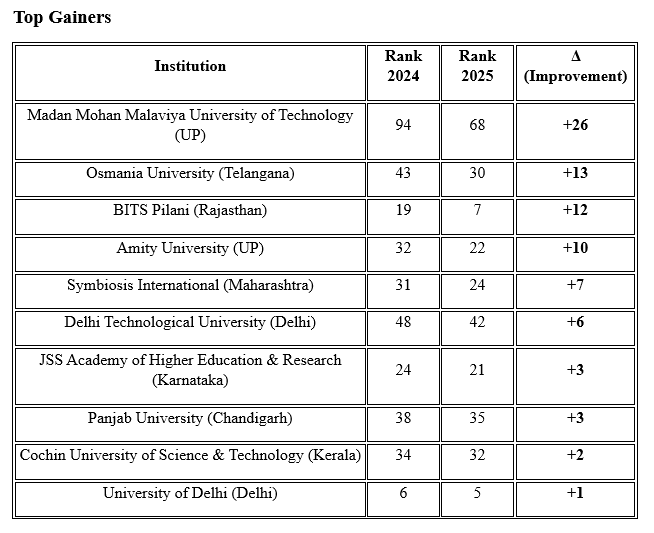
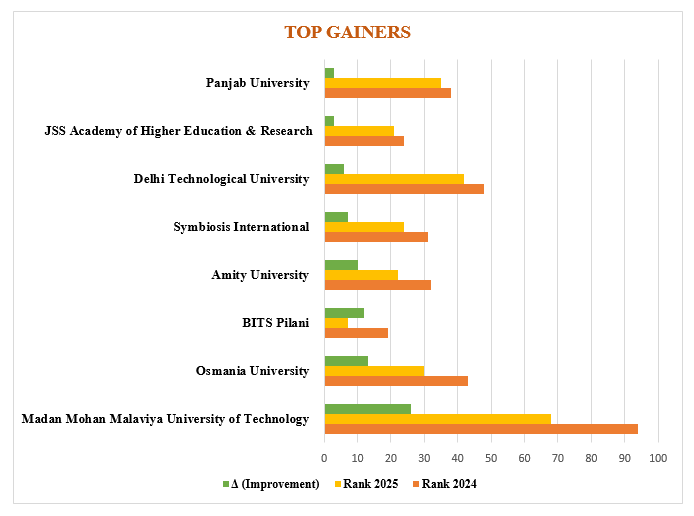
Observation:
The standout story is MMMUT’s leap of 26 positions, breaking into the mid-table for the first time, followed closely by Osmania University and BITS Pilani, reflecting stronger research and graduate outcomes.
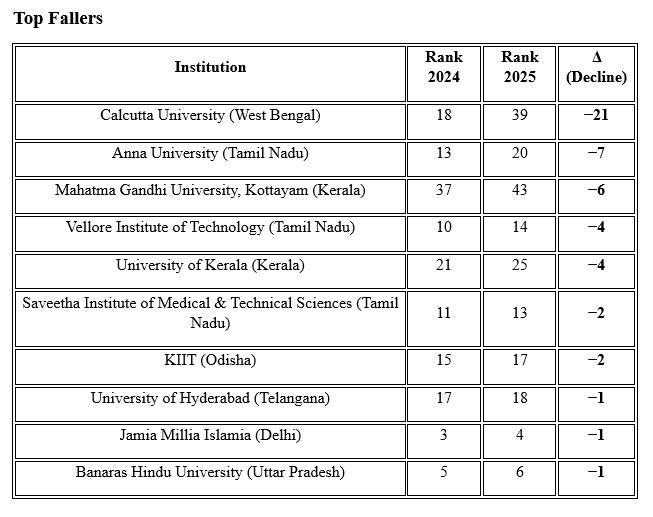
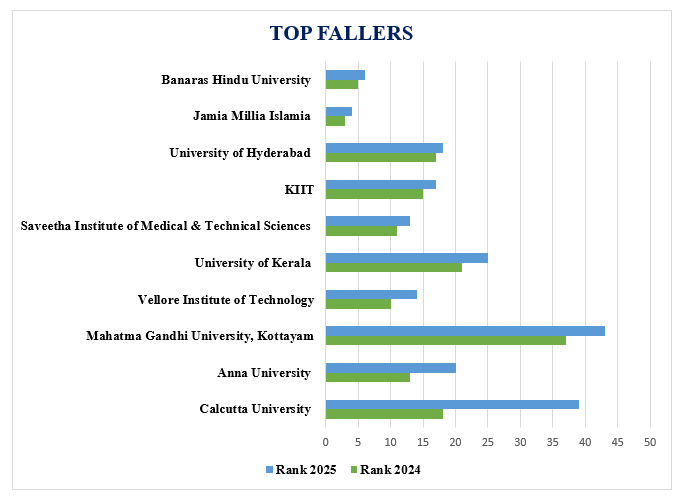
Observation:
Calcutta University’s significant drop of 21 positions signals the need for renewed focus on research output and perception metrics.
10 Insights from the Top 100 Universities
- Diversity of Models at the Top
The podium showcases multiple governance frameworks:
- Central public universities: JNU, DU, BHU, AMU.
- Private/deemed universities: MAHE, BITS, Amrita.
- State universities: Jadavpur.
This mix signals a balanced and resilient ecosystem, proving that excellence isn’t tied to a single institutional model.
- IISc’s Sustained Dominance
IISc’s leadership comes from:
- High research intensity (RPC): Global-level publications and patents.
- Advanced infrastructure and faculty strength (TLR).
- International collaborations that enhance graduate outcomes and perception.
It embodies the research-first, teaching-strong paradigm other universities aim to replicate.
- Delhi: India’s Academic Capital
Three of the Top 5 universities are based in Delhi:
- JNU (#2) for research and humanities leadership.
- JMI (#4) for inclusivity and outreach excellence.
- DU (#5) for undergraduate quality and vast research networks.
This concentration is supported by:
- Access to national labs and funding agencies.
- Dense policy and research linkages.
- Strong alumni and recruitment ecosystems.
- The Rise of Private Universities
Private universities are now competing head-to-head with central institutions:
- MAHE (#3): Strong global tie-ups and placements.
- BITS Pilani (#7): Growing research footprint alongside top-tier outcomes.
- Amrita (#8): Interdisciplinary leadership, particularly in health sciences.
This reflects private sector maturity and long-term investment in research and student success.
- Legacy State Universities Hold Their Ground
- Jadavpur University (#9): Consistently strong in engineering and foundational sciences.
- Universities like Calcutta University retain relevance in humanities and social sciences.
These institutions remain vital for accessible, quality education at scale.
- South India’s Strength
Tamil Nadu and Karnataka feature prominently in the Top 100:
- Specialized institutions such as TNAU (agriculture) and Sri Ramachandra University (health sciences) stand out.
- This dominance stems from decades of consistent higher education policy and industry-academia integration.
- Year-over-Year Momentum
Significant upward moves highlight dynamic competition:
- Osmania University (Telangana): #43 → #30 (+13)
- MMMUT (Uttar Pradesh): #94 → #68 (+26)
Such improvements often result from strategic investments in research and career services.
- Specialized Universities in the Mid-Tier
Ranks 20–80 are increasingly populated by niche institutions:
- Agriculture: TNAU, PAU.
- Health Sciences: KGMU, Chettinad, Sri Ramachandra.
- Social Sciences & Technology: TISS, IIIT Hyderabad.
These universities show that focused excellence translates into national impact.
- Perception vs. Performance
Several institutions rise despite modest perception scores due to:
- Strong Research & Professional Practice (RPC) metrics.
- Improved Graduation Outcomes (GO).
Key Takeaway:
Data-driven performance can outweigh branding in determining rank.
- The 2026 Playbook
With stable scoring weights, universities should focus on:
- TLR: Hiring and retaining PhD-qualified faculty, upgrading labs and libraries.
- RPC: Funding research and protecting intellectual property.
- GO: Enhancing placements, postgraduate admissions, and alumni networks.
These durable levers ensure consistent upward mobility.
Conclusion: A System in Motion
The NIRF 2025 University Rankings showcase a system that is:
- Rooted in tradition, with IISc, JNU, DU, and BHU setting benchmarks.
- Evolving through innovation, led by private universities like MAHE, BITS, and Amrita.
- Expanding inclusively, with specialized institutions earning national recognition.
As competition intensifies, universities must focus on research depth, teaching quality, inclusivity, and measurable student success.
These rankings are more than numbers, they reflect India’s commitment to building a knowledge-driven, equitable, and globally competitive academic ecosystem.
The future of Indian higher education lies in collaboration between legacy institutions and rising stars, with a shared mission of excellence and impact.
Dr. Mendus Jacob, is the CEO of ipsr solutions limited and Professor & Director of the MCA Programme at Marian College, Kuttikkanam (Autonomous), with over 35 years of experience as an academician and entrepreneur. He is the former Director of School of Applicable Mathematics, M. G. University, Kerala. A Ph.D. in Operations Research with numerous publications, he has served on academic bodies of universities and autonomous institutions, produced Ph.D.s, and been a sought-after resource person for global conferences and faculty development programmes. An expert in NEP, Outcome Based Education, and Accreditation, he has mentored prestigious universities and trained over 40,000 faculty members nationwide on OBE implementation.













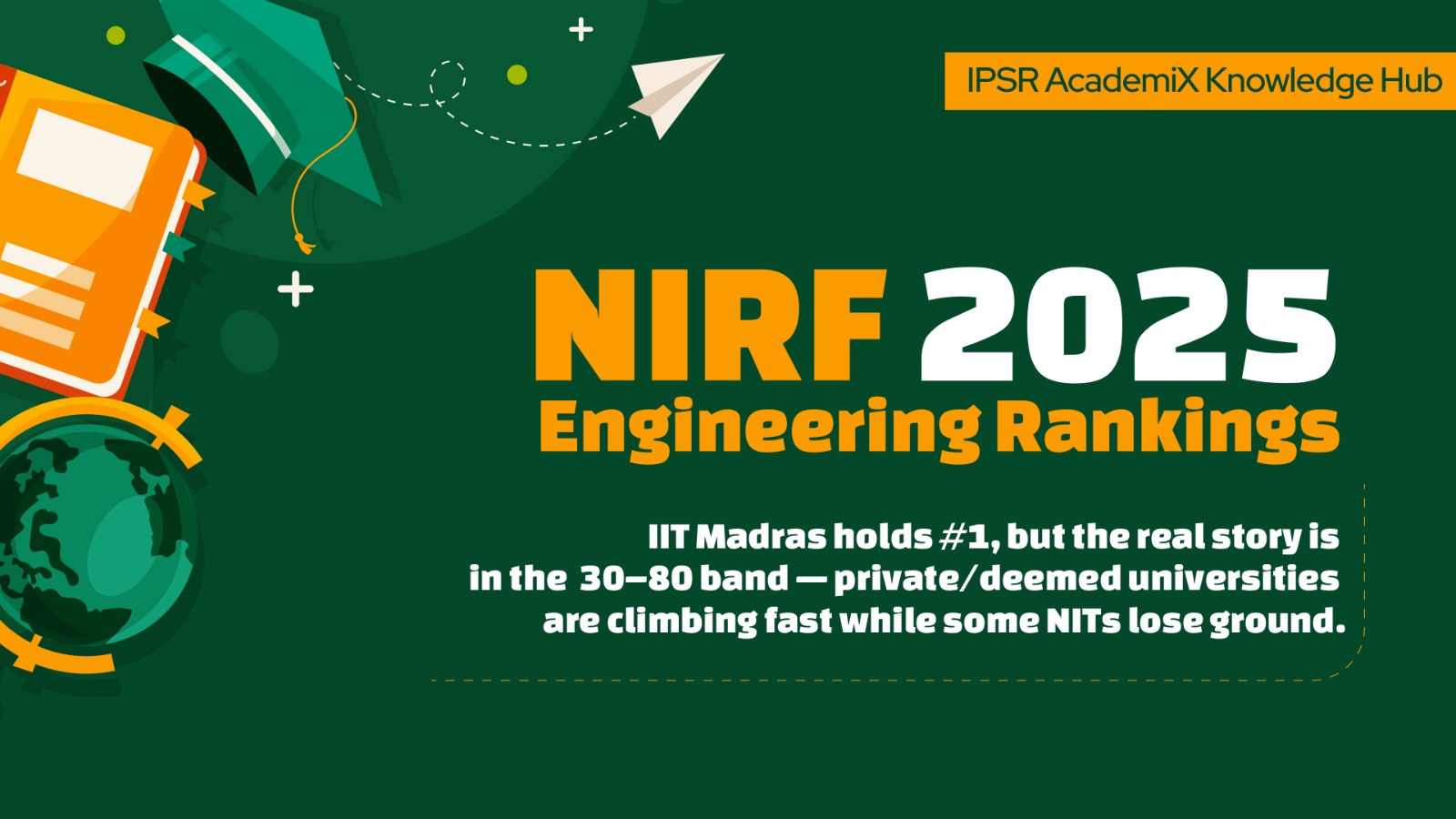


Leave A Comment